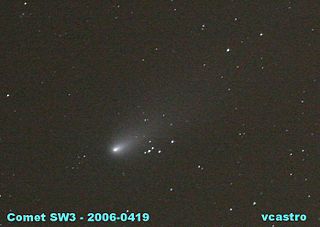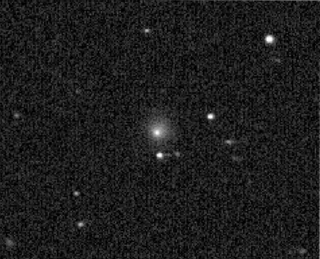
32P/Comas Solà is a periodic comet with a current orbital period of 8.8 years.

12P/Pons–Brooks is a periodic comet with an orbital period of 71 years. It fits the classical definition of a Halley-type comet with an orbital period between 20 and 200 years, and is also one of the brightest known periodic comets, reaching an absolute visual magnitude ~5 in its approach to perihelion. Comet Pons-Brooks was discovered at Marseilles Observatory in July 1812 by Jean-Louis Pons, and then later recovered in 1883 by William Robert Brooks.

Tempel 1 is a periodic Jupiter-family comet discovered by Wilhelm Tempel in 1867. It completes an orbit of the Sun every 5.6 years. Tempel 1 was the target of the Deep Impact space mission, which photographed a deliberate high-speed impact upon the comet in 2005. It was re-visited by the Stardust spacecraft on February 14, 2011, and came back to perihelion in August 2016. On 26 May 2024, it will make a modest approach of 0.55 AU to Jupiter which will lift the perihelion distance and 9P will next come to perihelion on 12 February 2028 when it will be 1.77 AU from the Sun.

16P/Brooks, also known as Brooks 2, is a periodic comet discovered by William Robert Brooks on July 7, 1889, but failed to note any motion. He was able to confirm the discovery the next morning, having seen that the comet had moved north. On August 1, 1889, the famous comet hunter Edward Emerson Barnard discovered two fragments of the comet labeled "B" and "C" located 1 and 4.5 arc minutes away. On August 2, he found another four or five, but these were no longer visible the next day. On August 4, he observed two more objects, labeled "D" and "E". "E" disappeared by the next night and "D" was gone by the next week. Around mid-month, "B" grew large and faint, finally disappearing at the beginning of September. "C" managed to survive until mid-November 1889. The apparition ended on January 13, 1891. After the discovery apparition, the comet has always been over two magnitudes fainter.
Comet 87P/Bus is a periodic comet with an orbital period of 6.5 years. It fits the definition of an Encke-type comet with. It was discovered by Schelte J. Bus in 1981 on a plate taken with the 1.2m UK Schmidt telescope at Siding Spring, Australia. The discovery was announced in IAU Circular 3578 on March 4, 1981.

Comet 4P/Faye is a periodic Jupiter-family comet discovered in November 1843 by Hervé Faye at the Royal Observatory in Paris. Its most recent perihelia were on November 15, 2006; May 29, 2014; and September 8, 2021.

10P/Tempel, also known as Tempel 2, is a periodic Jupiter-family comet with a 5 year orbital period. It was discovered on July 4, 1873 by Wilhelm Tempel. The next perihelion passage is 2 August 2026 when the comet will have a solar elongation of 164 degrees at approximately apparent magnitude 8. Closest approach to Earth will be one day later on 3 August 2026 at a distance of 0.414 AU (61.9 million km).

52P/Harrington–Abell is a periodic comet in the Solar System.

73P/Schwassmann–Wachmann, also known as Schwassmann–Wachmann 3 or SW3 for short, is a periodic comet that has a 5.4 year orbital period and that has been actively disintegrating since 1995. When it came to perihelion in March 2017, fragment 73P-BT was separating from the main fragment 73P-C. Fragments 73P-BU and 73P-BV were detected in July 2022. The main comet came to perihelion on 25 August 2022, when the comet was 0.97 AU from the Sun and 1 AU from Earth. It will be less than 80 degrees from the Sun from 25 May 2022 until August 2023. On 3 April 2025 it will make a modest approach of 0.3 AU to Jupiter. 73P will next come to perihelion on 23 December 2027 when it will be 0.92 AU from the Sun and on the far side of the Sun 1.9 AU from Earth.

77P/Longmore is a periodic comet in the Solar System, with a period of 6.8 years.

101P/Chernykh is a periodic comet which was first discovered on August 19, 1977, by Nikolaj Stepanovich Chernykh. It will next come to perihelion in 2034.

157P/Tritton is a periodic comet with a 6-year orbital period. Fragment B was first observed on 21 August 2022.

Comet Finlay is a periodic comet with an orbital period of 6 years discovered by William Henry Finlay on September 26, 1886. The next perihelion passage is July 13, 2021 when the comet will have a solar elongation of 54 degrees at approximately apparent magnitude 10. It last came to perihelion on December 27, 2014, at around magnitude 10. Of the numbered periodic comets, the orbit of 15P/Finlay has one of the smallest minimum orbit intersection distances with the orbit of Earth (E-MOID). In October 2060 the comet will pass about 5 million km from Earth.
20D/Westphal was a periodic comet with an orbital period of 61 years. It fits the classical definition of a Halley-type comet. The comet appeared to disintergrate during the 1913 apparition and hasn't been observed since then.

Rudolf Ferdinand Spitaler was an Austrian astronomer, geophysicist, meteorologist and climatologist.
D/1770 L1, popularly known as Lexell's Comet after its orbit computer Anders Johan Lexell, was a comet discovered by astronomer Charles Messier in June 1770. It is notable for having passed closer to Earth than any other comet in recorded history, approaching to a distance of only 0.015 astronomical units, or six times the distance from the Earth to the Moon. The comet has not been seen since 1770 and is considered a lost comet.
51P/Harrington is a periodic comet in the Solar System.
C/1890 V1 (Zona) is a non-periodic comet discovered on 15 November 1890 by the Italian astronomer Temistocle Zona with an equatorially mounted Merz telescope at the Osservatorio Astronomico di Palermo. Whilst attempting to observe this comet, Spitaler discovered the eponymous 113P/Spitaler in 1890.

97P/Metcalf–Brewington is a periodic Jupiter-family comet originally discovered by Joel H. Metcalf in 1906 but subsequently lost. A new observation in 1991 by Howard J. Brewington was matched to the 1906 sighting; the orbit was computed and the comet was observed again on its returns to perihelion in 2001, 2011, and 2022.

C/2017 K2 (PanSTARRS) is an Oort cloud comet with an inbound hyperbolic orbit, discovered in May 2017 at a distance beyond the orbit of Saturn when it was 16 AU (2.4 billion km) from the Sun. Precovery images from 2013 were located by July. It had been in the constellation of Draco from July 2007 until August 2020. As of June 2022, the 3-sigma uncertainty in the current distance of the comet from the Sun is ±6000 km.

















